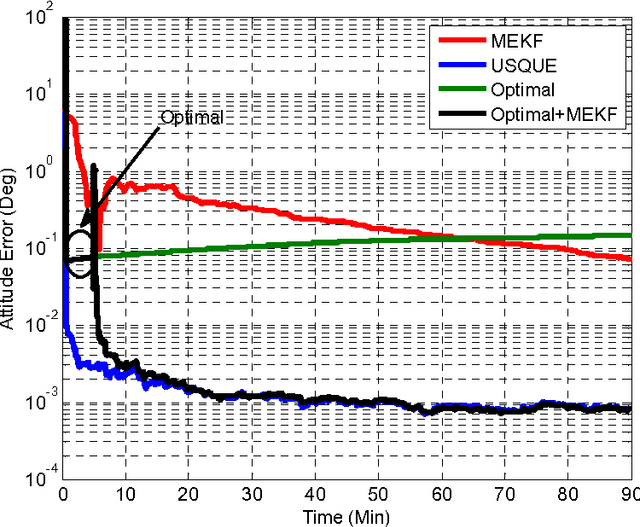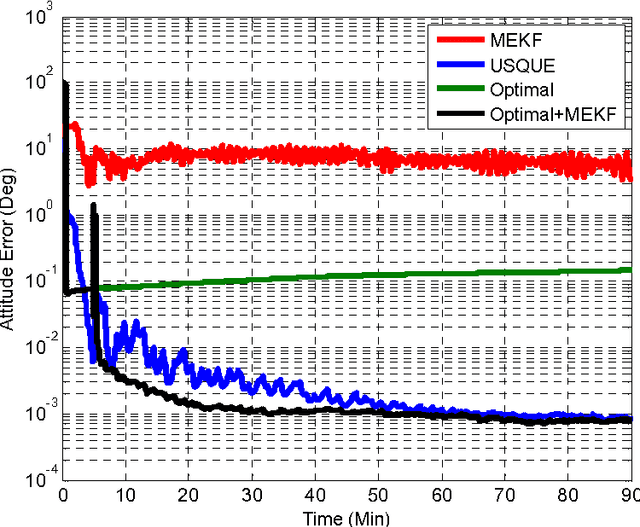Fangjun Qin
Inertial based Integration with Transformed INS Mechanization in Earth Frame
Mar 17, 2021



Abstract:This paper proposes to use a newly-derived transformed inertial navigation system (INS) mechanization to fuse INS with other complementary navigation systems. Through formulating the attitude, velocity and position as one group state of group of double direct spatial isometries SE2(3), the transformed INS mechanization has proven to be group affine, which means that the corresponding vector error state model will be trajectory-independent. In order to make use of the transformed INS mechanization in inertial based integration, both the right and left vector error state models are derived. The INS/GPS and INS/Odometer integration are investigated as two representatives of inertial based integration. Some application aspects of the derived error state models in the two applications are presented, which include how to select the error state model, initialization of the SE2(3) based error state covariance and feedback correction corresponding to the error state definitions. Extensive Monte Carlo simulations and land vehicle experiments are conducted to evaluate the performance of the derived error state models. It is shown that the most striking superiority of using the derived error state models is their ability to handle the large initial attitude misalignments, which is just the result of log-linearity property of the derived error state models. Therefore, the derived error state models can be used in the so-called attitude alignment for the two applications. Moreover, the derived right error state-space model is also very preferred for long-endurance INS/Odometer integration due to the filtering consistency caused by its less dependence on the global state estimate.
Strapdown Inertial Navigation System Initial Alignment based on Group of Double Direct Spatial Isometries
Feb 25, 2021



Abstract:The task of strapdown inertial navigation system (SINS) initial alignment is to calculate the attitude transformation matrix from body frame to navigation frame. In this paper, such attitude transformation matrix is divided into two parts through introducing the initial inertially fixed navigation frame as inertial frame. The attitude changes of the navigation frame corresponding to the defined inertial frame can be exactly calculated with known velocity and position provided by GNSS. The attitude from body frame to the defined inertial frame is estimated based on the SINS mechanization in inertial frame. The attitude, velocity and position in inertial frame are formulated together as element of the group of double direct spatial isometries.It is proven that the group state model in inertial frame satisfies a particular "group affine" property and the corresponding error model satisfies a "log linear" autonomous differential equation on the Lie algebra. Based on such striking property, the attitude from body frame to the defined inertial frame can be estimated based on the linear error model with even extreme large misalignments. Two different error state vectors are extracted based on right and left matrix multiplications and the detailed linear state space models are derived based on the right and left errors for SINS mechanization in inertial frame. With the derived linear state space models, the explicit initial alignment procedures have been presented. Extensive simulation and field tests indicate that the initial alignment based on the left error model can perform quite well within a wide range of initial attitude errors, although the used filter is still a type of linear Kalman filter. This method is promising in practical products abandoning the traditional coarse alignment stage.
Dynamic Analytical Initialization Method for Spacecraft Attitude Estimators
Jun 21, 2017



Abstract:This paper proposes a dynamic analytical initialization method for spacecraft attitude estimators. In the proposed method, the desired attitude matrix is decomposed into two parts: one is the constant attitude matrix at the very start and the other encodes the attitude changes of the body frame from its initial state. The latter one can be calculated recursively using the gyroscope outputs and the constant attitude matrix can be determined using constructed vector observations at different time. Compared with traditional initialization methods, the proposed method does not necessitate the spacecraft being static or more than two non-collinear vector observations at the same time. Therefore, the proposed method can promote increased spacecraft autonomy by autonomous initialization of attitude estimators. The effectiveness and prospect of the proposed method in spacecraft attitude estimation applications have been validated through numerical simulations.
 Add to Chrome
Add to Chrome Add to Firefox
Add to Firefox Add to Edge
Add to Edge